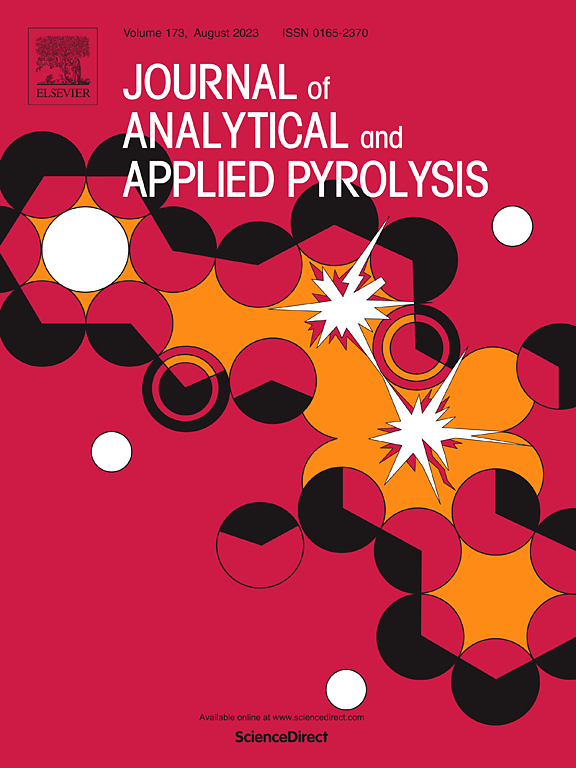Analysis of micro/nanoplastics on the surface of polystyrene foam lunch boxes by pyrolysis-gas chromatography/mass spectrometry
IF 6.2
2区 化学
Q1 CHEMISTRY, ANALYTICAL
引用次数: 0
Abstract
In this work, membrane filtration and ultrafiltration centrifugation were used to separate and concentrate micro/nanoplastics attached on the surface of polystyrene (PS) foam lunch boxes. A pyrolysis-gas chromatography/mass spectrometry (Py-GC/MS) method was established to determine the content of PS micro/nanoplastics, expressed as a mass concentration, which was more suitable for the data comparison. The inner surface of a PS foam lunch box was rinsed with ultrapure water, and the PS microplastics in the rinse water were collected through a glass fiber membrane with pore size of 1 μm. Subsequently, an ultrafiltration centrifuge tube (100 kDa) was used to filter the filtrate again to collect the PS nanoplastics. The obtained PS micro/nanoplastics were qualitatively and quantitatively analyzed by Py-GC/MS. It was found that 8.52–11.43 μg/box of PS microplastics and 0.104–0.154 μg/box of PS nanoplastics were attached on the surface of three batches of PS foam lunch boxes. The detected mass of microplastics was 55.3–109.9 times that of nanoplastics. The particle number of PS nanoplastics is estimated about 1.21 × 10^7 and 1.79 × 10^7 items/box. The method validation showed that the absolute recoveries of PS microplastics and nanoplastics were 91.4 ± 11.3 % and 61.7 ± 7.5 %, respectively. The results demonstrated that the proposed method can be applied to the qualitative and quantitative analysis of micro/nanoplastics on the surface of food contact materials, providing references for the safe use of food contact materials.
热裂解-气相色谱-质谱法分析聚苯乙烯泡沫餐盒表面微/纳米塑料
本文采用膜过滤和超滤离心分离法对聚苯乙烯(PS)泡沫餐盒表面附着的微纳塑料进行分离浓缩。建立了热解-气相色谱/质谱法(Py-GC/MS)测定PS微/纳米塑料含量的方法,以质量浓度表示,更适合于数据比较。采用超纯水对PS泡沫餐盒内表面进行漂洗,通过孔径为1 μm的玻璃纤维膜收集漂洗水中的PS微塑料。随后,使用超滤离心管(100 kDa)再次过滤滤液,收集PS纳米塑料。采用Py-GC/MS对制备的PS微/纳米塑料进行定性和定量分析。结果发现,三批PS泡沫餐盒表面的PS微塑料含量为8.52 ~ 11.43 μg/盒,PS纳米塑料含量为0.104 ~ 0.154 μg/盒。微塑料的检测质量是纳米塑料的55.3-109.9 倍。PS纳米塑料的颗粒数估计为1.21 × 10^7和1.79 × 10^7个/盒。方法验证表明,PS微塑料和纳米塑料的绝对回收率分别为91.4 ± 11.3 %和61.7 ± 7.5 %。结果表明,该方法可用于食品接触材料表面微/纳米塑料的定性和定量分析,为食品接触材料的安全使用提供参考。
本文章由计算机程序翻译,如有差异,请以英文原文为准。
求助全文
约1分钟内获得全文
求助全文
来源期刊
CiteScore
9.10
自引率
11.70%
发文量
340
审稿时长
44 days
期刊介绍:
The Journal of Analytical and Applied Pyrolysis (JAAP) is devoted to the publication of papers dealing with innovative applications of pyrolysis processes, the characterization of products related to pyrolysis reactions, and investigations of reaction mechanism. To be considered by JAAP, a manuscript should present significant progress in these topics. The novelty must be satisfactorily argued in the cover letter. A manuscript with a cover letter to the editor not addressing the novelty is likely to be rejected without review.

 求助内容:
求助内容: 应助结果提醒方式:
应助结果提醒方式:


